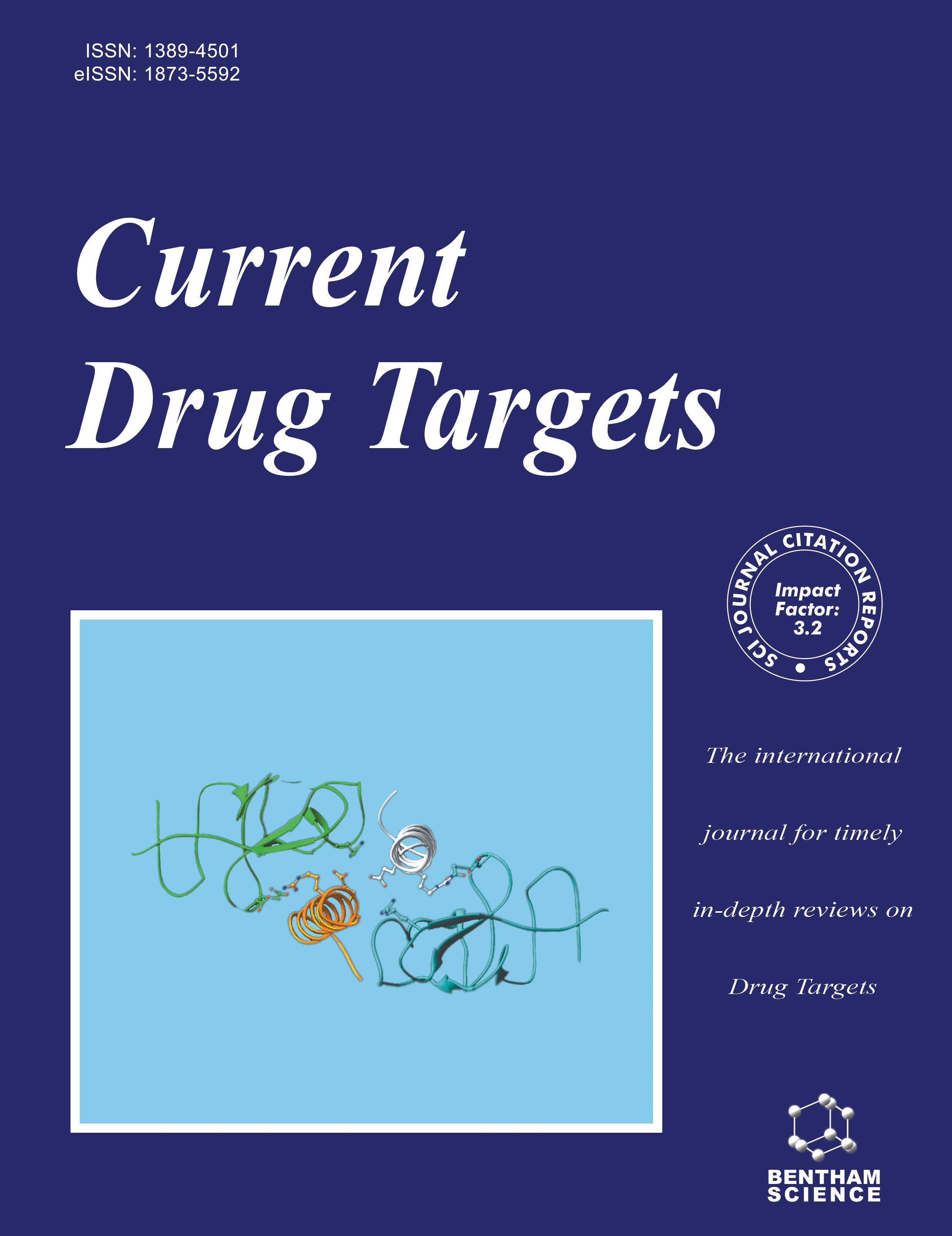- Home
- A-Z Publications
- Current Drug Targets
- Previous Issues
- Volume 17, Issue 1, 2016
Current Drug Targets - Volume 17, Issue 1, 2016
Volume 17, Issue 1, 2016
-
-
HIV-1 Tat-Mediated Calcium Dysregulation and Neuronal Dysfunction in Vulnerable Brain Regions
More LessBy Xiu-Ti HuDespite the success of combined antiretroviral therapy, more than half of HIV-1-infected patients in the USA show HIV-associated neurological and neuropsychiatric deficits. This is accompanied by anatomical and functional alterations in vulnerable brain regions of the mesocorticolimbic and nigrostriatal systems that regulate cognition, mood and motivation-driven behaviors, and could occur at early stages of infection. Neuro Read More
-
-
-
Targeting TNF-Alpha in HIV-1 Infection
More LessAuthors: Amit Kumar, Laurie Coquard and Georges HerbeinHighly active antiretroviral therapy (HAART) has dramatically extended the lifespan and quality of life of individuals infected with human immunodeficiency virus type 1 (HIV-1). HAART comprises of a cocktail of various pharmacological inhibitors which interfere with almost every stages of HIV-1 life cycle. However, constant application of drugs often results in the evolution of hostpathogen relationship resulting in t Read More
-
-
-
HIV-1 Matrix Protein p17 and its Receptors
More LessAuthors: Francesca Caccuri, Stefania Marsico, Simona Fiorentini, Arnaldo Caruso and Cinzia GiagulliThe HIV-1 matrix protein p17 (p17) plays a crucial role in the virus life cycle. It is released in the extracellular space from HIV-1-infected cells and accumulates in the tissues of patients, even in those successfully treated with highly active antiretroviral therapy. Extracellular p17 deregulates the biological functions of many different cells that are directly or indirectly implicated in AIDS pathogenesis. All p17 actions depend on inter Read More
-
-
-
HIV-1 TAT and IMMUNE DYSREGULATION in AIDS PATHOGENESIS: a THERAPEUTIC TARGET
More LessAuthors: Chiara Chiozzini and Elena ToschiThe HIV-1 transactivator Tat protein plays a key role in AIDS pathogenesis. Besides the Tat role as activator of HIV-1 transcription, it exerts several important functions on infected and uninfected cells. In fact, HIV-1 Tat is released by infected cells and is taken up by neighboring cells. In this way it regulates expression of viral and cellular genes and it modulates several cellular pathways leading to HIV-1 infection spreading and imm Read More
-
-
-
The Contribution of Extracellular Nef to HIV-Induced Pathogenesis
More LessNef is an accessory protein expressed exclusively in primate lentiviruses. It is devoid of enzymatic activities while interacting with several cell proteins as an adaptor/scaffold protein. Intracellular functions of Nef largely account for many pathogenic effects observed in AIDS disease. Nef, despite lacking known secretory pathways, can be detected in plasma of HIV-1-infected patients at the concentration varing from 5 to 1 Read More
-
-
-
Release of Soluble Ligands for the Activating NKG2D Receptor: One More Immune Evasion Strategy Evolved by HIV-1 ?
More LessAuthors: Erica Giuliani, Lia Vassena, Cristina Cerboni and Margherita DoriaIncreasing lines of evidence indicate that NKG2D, an activating receptor of natural killer (NK) and CD8+ T cells, plays an important role in immune responses against HIV-1. Through its ability to recognize a diverse array of ligands (NKG2DLs) induced by cell ‘stress’ such as viral infection, NKG2D delivers activating and co-stimulatory signals resulting in cytotoxicity and release of cytokines. Therefore, HIV-1 and other viruses have Read More
-
-
-
HIV-1 Cell-to-Cell Transmission and Antiviral Strategies: An Overview
More LessHIV-1 replicates by infecting new target cells either as cell-free viral particle or, much more efficiently, via cell-to-cell viral transmission. Cell-mediated viral spread, in which the infected cell directly transfers the viral particles to target cells via cell-cell contacts, in vitro is up to three orders of magnitude more efficient than transmission mediated by cell-free viral particles. Because of its potency, it has been suggested that c Read More
-
-
-
The CCL2/CCR2 Axis in the Pathogenesis of HIV-1 Infection: A New Cellular Target for Therapy?
More LessAuthors: Daniela Angela Covino, Michela Sabbatucci and Laura FantuzziThe identification of chemokine receptors as necessary co-receptors for HIV entry into target cells represented a breakthrough in the understanding of the pathogenesis of this viral infection. Since this initial discovery, it was unraveled that chemokines, in addition to their role in blocking viral entry by binding to co-receptors, have other functions in HIV pathogenesis. Indeed, chemokines can either inhibit or enhan Read More
-
-
-
CXCL8 as a Potential Therapeutic Target for HIV-Associated Neurocognitive Disorders
More LessAuthors: Manmeet K. Mamik and Anuja GhorpadeChemokine CXCL8 is a low molecular weight neutrophil chemoattractant implicated in various neurodegenerative disorders including Alzheimer's disease and stroke. Increased expression of CXCL8 has been reported in serum, plasma and brain of human immunodeficiency virus (HIV)-1 infected individuals with neurocognitive impairment, indicating its role in neuroinflammation associated with HIV-1 infection of the brain. Read More
-
-
-
HIV-1 gp120: A Target for Therapeutics and Vaccine Design
More LessAuthors: Claudia Cicala, Fatima Nawaz, Katija Jelicic, James Arthos and Anthony S. FauciAlthough extraordinary progress has been made in the treatment and prevention of HIV infection, the AIDS pandemic continues to rage globally with 2.1 million infections and 1.6 million AIDS-related deaths reported in 2013. Until an effective vaccine is developed, new strategies for treatment and prevention are needed. Regarding the prevention of HIV infection, a major focus of prevention research in general and v Read More
-
Volumes & issues
-
Volume 26 (2025)
-
Volume 25 (2024)
-
Volume 24 (2023)
-
Volume 23 (2022)
-
Volume 22 (2021)
-
Volume 21 (2020)
-
Volume 20 (2019)
-
Volume 19 (2018)
-
Volume 18 (2017)
-
Volume 17 (2016)
-
Volume 16 (2015)
-
Volume 15 (2014)
-
Volume 14 (2013)
-
Volume 13 (2012)
-
Volume 12 (2011)
-
Volume 11 (2010)
-
Volume 10 (2009)
-
Volume 9 (2008)
-
Volume 8 (2007)
-
Volume 7 (2006)
-
Volume 6 (2005)
-
Volume 5 (2004)
-
Volume 4 (2003)
-
Volume 3 (2002)
-
Volume 2 (2001)
-
Volume 1 (2000)
Most Read This Month
Article
content/journals/cdt
Journal
10
5
false
en


